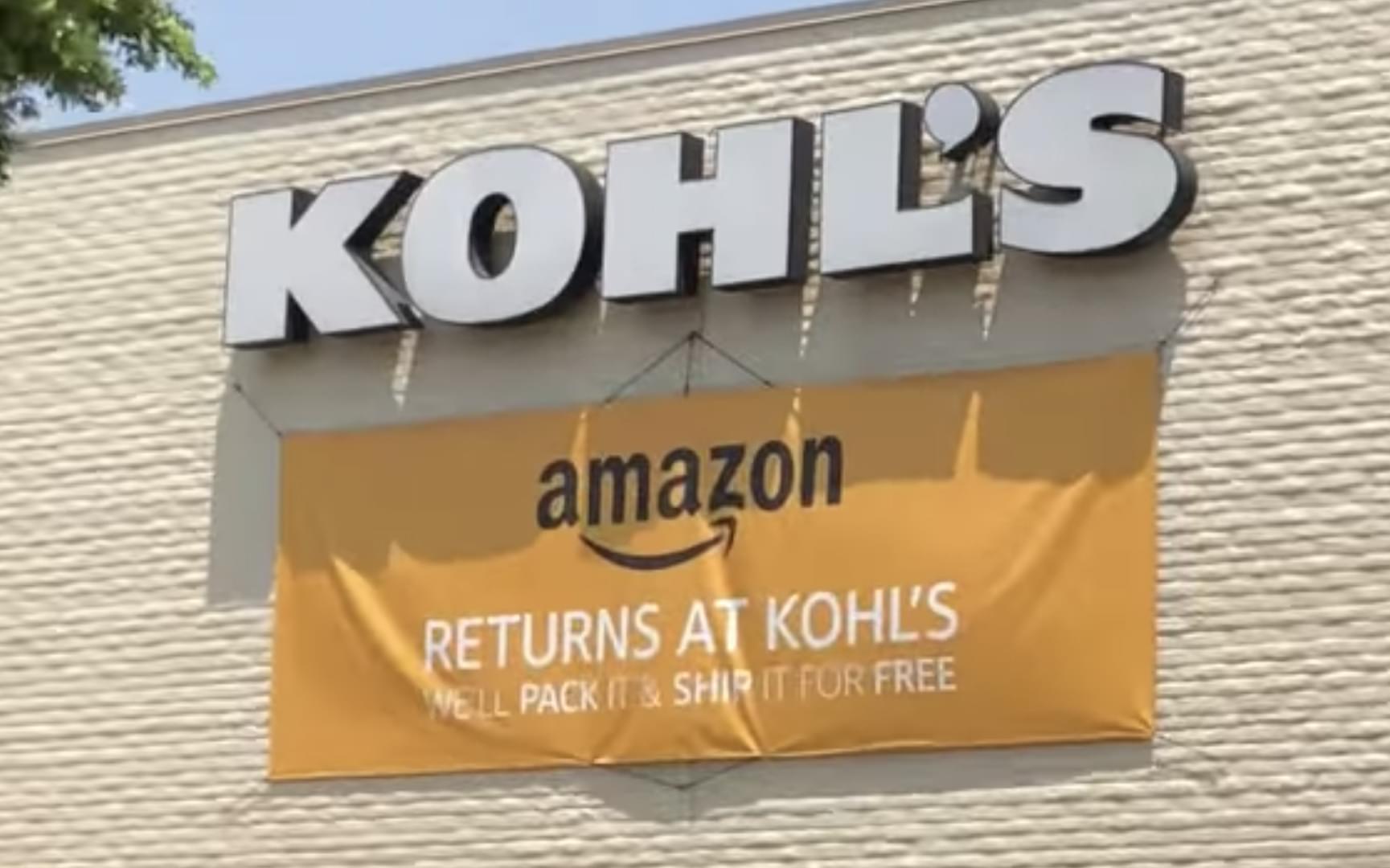- In 2019, all Kohl’s stores started accepting and packaging Amazon returns, at no cost to the customer, and shipping them to Amazon fulfillment centers.
- This partnership has clear benefits for Kohl’s — mainly a supply of dissatisfied Amazon customers streaming into their stores — but it’s less obvious what notoriously competitive Amazon is getting from it.
- Is forming a partnership the new acquisition? Instead of buying a smaller company with a particular set of skills, could larger companies get more out of teaming up with them?
The point of having competitors is typically to defeat them. That’s the way it is with sports, politics and pie-eating contests, and that’s the way it typically is with business. So why has the most ruthless of business competitors apparently teamed up with a rival?
In 2017, department chain Kohl’s announced that 82 of its stores in LA and Chicago would start accepting Amazon returns. Customers wouldn’t even have to go to the trouble of forcing their no-good product back into its box. Kohl’s would repackage the products destined for return, and ship them back to Amazon, all at no charge to the customer. It must have worked: in 2019, Kohl’s extended the service to all of its 1,150+ stores nationwide. (Except Anchorage, Alaska. Sorry, northern friends.)
This partnership has raised eyebrows. Amazon and the ecommerce movement it helped create was the David that took down the department store Goliaths. As recently as 2016, without mentioning Amazon directly, Kohl’s announced that it would be closing 18 stores, ultimately replacing them with smaller ones.
It seems that there’s no bitterness on Kohl’s end. But what is each of these competitors getting from their partnership? On an episode of The Accidental Marketer, we discussed the pros and cons for Amazon and Kohl’s, and whether this could mark a move towards a more symbiotic approach between competing companies.
Kohl’s looks like a winner in this arrangement
The lions share of the benefits of this deal seem to be going to Kohl’s, though that is debatable.
At the top level, Amazon is effectively sending customers into Kohl’s stores. And not just any customers: customers who were so unimpressed with the merchandise they bought from Amazon that they’re willing to go through the process of returning it.
To frame it from the other side, Kohl’s is laying out the welcome mat for the people Amazon failed to serve effectively, at the exact moment when their frustration with Amazon is at its peak.
Not only that, but the grumpy person holding their broken Amazon toaster probably still needs a toaster. If they can find a replacement in Kohl’s, they’re primed to buy it. To capitalize on this irritation even further, Kohl’s has historically offered coupons to customers doing Amazon returns at their stores.
Kohl’s does have to cover the cost of repacking and shipping the returned packages to Amazon. But — depending on how you look at it — Kohl’s seems to be benefitting, at least according to CEO Michelle Gass.
While it’s important to note that recent financial results at Kohl’s have been less-than-stellar, they have been slightly better than it’s peer group. And as typically happens with creative strategies that don’t immediately work out, Gass is facing some pressure from stockholders about the strategy. But she sees positive longer-term benefits.
“Amazon is working. This returns program is working. We’re seeing the traffic. We’re getting new customers,” she told CNBC.
“We’re getting a younger customer,” Gass said. “And to what we expected, some of them were buying. … You’re never going to get 100%. But some of them are buying.”
Untangling what Amazons gets out of this partnership
Kohl’s incentive for the partnership is clear — customer acquisition. But the benefits to Amazon are a little muddier.
To say that Amazon is not known for having a friendly attitude towards competitors is like saying that Jeff Bezos is quite rich. Stories about Amazon’s relationship with competing brands typically make free use of words like “crushing,” “steamrolling,” “ruthless” and “brutally competitive.”
So why is Amazon participating in a scheme that, at least on the surface, clearly benefits a competitor?
One possibility is that this is a well-disguised trick designed to gather information about Kohl’s, so Amazon can take it down from the inside. A Trojan horse approach, if you will. Perhaps Amazon is using its Kohl’s partnership to test customers’ preferred return methods, before it invests in more of its own brick-and-mortar stores.
Another potential explanation is that Amazon understands that a certain segment of its customers are befuddled by the concept of returning a package to a website, and prefer an in-person return experience — especially one that takes care of the repackaging.
Amazon’s reach is now so broad that its customer base extends beyond the tech-savvy. It’s serving people who’ve never used Facebook, but are grateful for the convenience of ordering denture cream online. Many people in this demographic grew up thinking of the department store as the one place that has everything. The Kohl’s/Amazon partnership associates the latter with the former, and in doing so, it highlights Amazon as the more convenient, 21st-century version of something people already understand.
Maybe Amazon really has accepted that Kohl’s has staying power, and it’s time to work with it, not against it. Equally likely, we just haven’t seen its plan come to fruition yet.
The Kohl’s/Amazon partnership isn’t the only example of competitors teaming up
As surprising as this partnership is, there are other examples of competitors working together to offer customers a better experience, which ultimately benefits both rivals.
This is especially true in technology. For example, the home security space often sees multiple companies providing open source software that can work with their competitors’ offerings, because customers want everything to be able to talk to each other.
There’s also the more traditional version of the rival becoming the ally, in which the bigger company buys out the smaller one that does something the bigger company doesn’t have the tech to do yet.
In some ways, the Kohl’s/Amazon deal is a new iteration of the acquisition. Both companies are using each other to add a value proposition they can’t offer on their own.
Kohl’s cannot compete with Amazon’s ability to attract online customers — so it picks up the ones who aren’t happy with Amazon’s service. And Amazon doesn’t have enough brick-and-mortar stores to offer in-person returns: not yet, anyway.
By joining forces, both companies get to stay separate, while also adding benefits to entice customers.
Be open-minded about working with your competitors
The lesson from this interesting example of competitors throwing aside their differences and skipping hand-in-hand through a field of customer returns is that you should be open-minded about partnerships that can help you improve your customers’ experiences. Even when it involves teaming up with a rival.
Specifically, when you analyze customer’s perceived shortcomings of your value proposition, you should add one more option to the idea list. In addition to investing in improving your own capabilities, acquiring them, or partnering with a complementor, you can do as Kohl’s did and team-up with a competitor. But be careful.
Bottom line: We don’t entirely understand Amazon’s motives for this deal. The company’s track record suggests a partner like Kohl’s should be cautious — even though the legacy department store has seemed to benefit from the partnership so far. And both companies have something to gain.
Maybe this is less a Trojan horse than a cash cow.
This article is based on an episode of The Accidental Marketed Podcast, which focuses on important B2B strategic marketing issues. Our growing episode catalog is designed to help listeners maximize profits in their area of responsibility by creating, communicating and capturing (via pricing strategies) more value for customers than competitors do.

 Mary Abbazia
Mary Abbazia Tom Spitale
Tom Spitale Sean Welham
Sean Welham